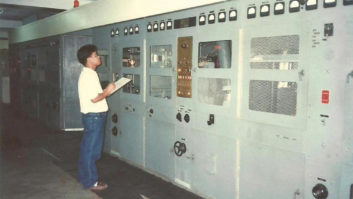Multiple contractors may have responsibilities at a transmitter site without any of them ever considering the overall well-being of that site. Consider the following real-life examples.
Transmitter upgrade
Two new 30 kW solid-state FM transmitters were to be installed at a combined FM site. The heating and cooling contractor installed two new expensive air-conditioning systems and turned off the original fan ventilation system because who would ever use that again?
A broadcast contractor then came in to install the transmitters along with a new remote-control system. All appeared to be working properly.
Yet the IT department of the station group had not yet opened a digital port for the remote to allow outgoing alarm messages. An over-temperature condition could have been read at the studio during regular checks, but who looks at that while taking transmitter readings?
The site is also home to an amateur radio repeater system, and when a ham operator visited on a summer day, he found the temperature in the building was a whopping 120 degrees! See Fig. 1.

He immediately informed station management. There was no station engineer, so the station called the air handling contractor to remedy the problem.
It turned out that pollen had plugged the air-conditioning condenser coils. This meant an expensive service bill for something that could have and should have been looked after by someone doing regular maintenance visits.
The fan cooling system could have been left in place to take over at 90 degrees when the new air handling equipment developed troubles. You can never have too many backups.
Electrical panels
It takes a human to do regular checks to monitor the overall health of a facility.
During such visits, put your palm on the fuse and circuit breaker enclosures; you may detect early signs of a problem. I found hot ones several times over the years. A look inside will reveal the story. A call to an electrician can resolve the problem before you have a complete failure.
Watching after it
There is always something. Vandals break things (Fig. 2), mice get in, motor bearings squeak when they need replacement, people dump trash at a site, there are break-ins, tower fences might need repair, there might be roof leaks and trees can fall on the road or even on guy lines.

In one instance, a local contractor was hired to clear brush and small trees from inside the tower fences of an AM directional site. There was no one at the station to supervise the work or shut down the transmitter to make it RF safe for workers.
In the process, one of the half-inch antenna monitor sample lines accidentally was cut, which was not reported. Antenna monitor readings that night showed a problem. A consultant was called in from out of town to troubleshoot and ultimately splice the monitor line. In the end it cost a lot of money because no one from the station had been overseeing the work.
Power generators
Backup power generators are notorious for providing homes for mice that like to chew through wires. Perform a visual inspection once a month. It only takes a moment, assuming you visit the site in the first place.
You may be tempted to test your generators for just a few seconds (Fig. 3), to confirm that the engine will start. But will it produce power? Will it overheat after the engine has been running for awhile due to lack of sufficient coolant?

In many cases, backup power generators are programmed to test themselves weekly. That’s well and good, but what if there’s a problem? Will anyone know?
I recommend that every backup power generator be tested in person for at least 20 minutes once a month, powering the studio or transmitter site it serves. You will detect any problems in the system immediately. After all, it needs to work when there is a real power failure.
STLs
Contractors look at their job with a narrow focus and usually won’t see or choose to ignore anything else. It is “not their problem.”
At one AM site, I found that a contractor had come in to update an STL system with new equipment. The STL system was running fine, but the contractor had not checked the audio level going into the audio processor or the transmitter modulation, which was only 40% when he left. Lacking a modulation monitor, the installer should have used an oscilloscope to check modulation. It wasn’t in the description of the work to be done.
Transmitter sites
At another site we found that the solid-state 1 kW AM transmitter had been damaged because of a roof leak and had to be sent back to the factory for an expensive repair. Water had come in only a drop at a time, but a month or so of that water torture was too much for the transmitter. No one knew there was a problem until the transmitter failed.
A contractor was hired to install a new tube in an FM transmitter. He adjusted the filament voltage to the required 5.0 volts. No one at the station knew to turn the filament voltage down a bit after the recommended 200 hours of break-in operation. In the end the tube experienced half of the life that it would have if the filament voltage had been turned down 10 percent or so.
Once I visited a site and found not one but two surge protectors that had come with new transmitters but not been installed by the contract engineer because it was electrician’s work (Fig. 4). Yet no one had called an electrician.

Remote readings
There was the announcer who didn’t bother to take readings on an AM directional, he just wrote down what they were supposed to be. No one complained. Finally the manager noticed the station had very good coverage at night. A check revealed that the station was in its day pattern at night — and likely had been for months.
Then there was the AM transmitter site where the main and auxiliary transmitters were fed by separate audio processors. When the main transmitter failed, the auxiliary was brought online, but there was no audio. Yes, one audio processor had failed, but no one had done regular testing to confirm that the auxiliary was working.
Such problems aren’t new.
Back in the days of Sine Systems dial-up remote-controls, the studio operators at one station took transmitter readings by phone. They logged that the temperature in the building kept going up and up and up. Ultimately the transmitter failed. The operators had dutifully taken the readings but didn’t understand or give thought to what they meant. That’s when I started programming remote controls to call out when an over-temperature condition existed.
Radio stations today are designed and computers are programmed to run facilities as autonomous machines. However, it takes a human to look after facilities in ways a computer can’t.
Read more Radio World tech tips articles here.
Mark Persons, WØMH, is an SBE Certified Professional Broadcast Engineer and is now retired, but still mentoring five radio broadcast engineers. He and his wife Paula were inducted into the Minnesota Broadcasters Hall of Fame after 44 years in business. His website is here.
Comment on this or any article. Write to [email protected].




